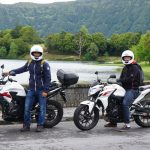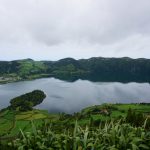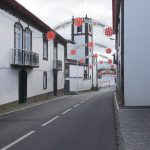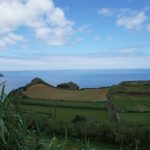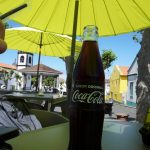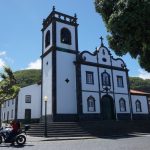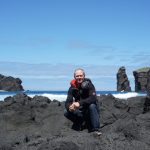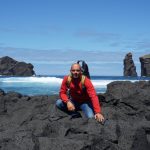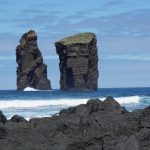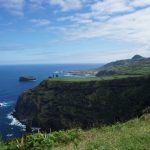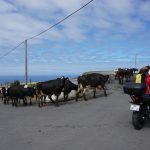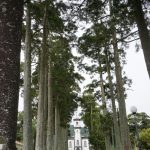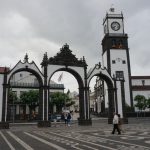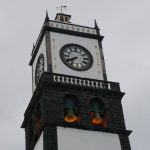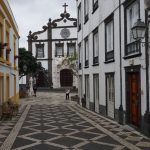Video (Crossing to Portimao)
FAIAL
After Flores it is fair to mention that Keraban was at anchor at the Westernmost bay of Europe. The crossing to Faial was simple, on the rumb line. Wind stayed for longer than forecast, enough to get us to the channel between Faial and Pico in the early morning before starting the engine. We did not lack dolphins and 4 whales completed the welcome committee upon arrival to Faial.
As expected, Horta’s marina was overcrowded with boats laying side by side, up to 4 rows. The proposition of having people walking over the boat and potentially stays and spreaders kissing in case of swell was not appealing, and we anchored between the mole and the Marina, quite comfortably indeed. You wonder why all the hassle to get squeezed in the harbor. By the abrupt stop, the anchor went under a stone….we will think about that later.
The third crew parted company and we took the rest of the day to sort out the boat, rinsing all gear and cleaning the interior, as well as taking all beds and clothing to the laundry.
As you walk the Horta marina you can admire the number of crew that have left their mark on the walls, in some cases the creativity and effort involved. We did not have the material to carry such artwork, and possibly not the motivation either, and rather headed for a well deserved beer as we waited for our lavomatic to complete its task, enjoying the mild temperature and watching the peak of nearby Pico surrounded by clouds.
One thing we did was explore Peter’s bar, and that is a third and final tick on the must be visited list of mariners hangouts, after Basil’s on Mustique and Foxy’s on Jost Van Dyke.
The best present was a quiet night sleep that left us well rested for the next day’s tour around the island. Faial is quite different from Flores, less rough nature, but also more obviously shaped by volcanic activity with the most recent eruption taking place in 1957. Starting from Horta, and this is common to all three islands we visited, one can not avoid but notice the care that is put on buildings and streets, as well as the relaxed atmosphere. Things slow down noticeably, not that we were coming from a stressed part of the world, I mean the Caribbean. Our clockwise driving around the island revealed splendid coastal views, including the “white fortress” (an homonymous shaped rock) and intense greenery. We put our Ford Focus to its paces following an off-road track around the coastline until we saw the famous volcano appearing before us. It is more a piece of art by nature than a volcano, with reddish, brown and black melting into curvaceous shapes and falling into the sea. The lighthouse, where its keeper had the courage to remain to take most of the pictures that exist of the 1957 eruption, stands starkly against that background and you could spend a day taking pictures trying to render the shapes and colors. There has been a major investment in an underground museum that tells the history of the volcano and as such of the entire archipelago, well worth the visit which includes climbing the lighthouse.
It was decided that we would leave Horta after just 2 nights, to allow for at least two nights in Sao Miguel. The family are already missing sailing (I like to think) and have decided to join in Ibiza on the 18th of June to complete the loop until Loano.
There are around 1,600nm to cover to get to Ibiza, and planning needs to allow for bad weather in the 1,000nm crossing to Gibraltar, or a Levanter at the later place, which blows East against the dominant Westerly Atlantic current, making the crossing of the Gibraltar Strait non-viable potentially for several days.
After a last evening enjoying the “best Gin in the waorld” at Peter’s and leaving a small trace there for W4L and Talitha, we lifted anchor the next morning, surprisingly with no problems with the underlying rocky bed.
The sailing to Sao Miguel, some 160nm, was with fair winds and we reached the harbor by noontime the next morning. The stern-to maneuver to get into our slot at Ponta Delgada is simple enough, but we did not account for the very low height of the finger pontoon, the fenders were high and I managed to make a scratch. I have a series of small scratches now to get sorted out once in Loano. It haunted me for a few hours but the bad mood disappeared as André and I decided it was about time to rent a motorbike (not a scooter) to visit this island. I have not ridden one in a while but I am sure my right wrist remembers the twisting action.
We liked each island for their own distinct features, but if I were to pick one it would be Sao Miguel (we only visited 3 of the entire archipelago of 7). The main city (Ponta Delgada) and villages are just beautiful, tidy and preserved through time, the scenery is a mixture of Alpine pastures and volcanic shapes, gifted with many lakes, natural hot water pools, large craters and so very gentle inhabitants. Sao Miguel is the largest of the islands we have visited and you would not feel contrived if you had to spend time there, as the distances are significant and the options during a stay many. It is not a coincidence then that there are daily direct flights from Boston to Sao Miguel, 4h.
Even if the skies are not entirely clear, we count on luck to avoid rain and jump on our saddles at 9 am sharp. Even found a pair of gloves onboard. 50km/h feels fast at the beginning, but there is no traffic and no one seems in a hurry. We take our time to get the senses used to the landscape passing a bit faster than on a boat. No wheelies.
We tour the Island clockwise with 2 main objectives: the twin lakes on one extreme of the Island, and the hot water pools on the other, about a 200km day, with many small villages in between. We hesitate at first to follow the exits descend onto the coastal villages but as soon as we discover how nice these are, we do a few unscheduled stops.
As we climb the hills we increasingly feel the chill. The arrival at the top of the crater surrounding the twin lakes is a sight to be seen. It is by far the largest crater or cauldron I have seen, bar maybe the one in Tenerife / Teide. During WWII seaplanes landed here. Descending the steep, twisty road down the village is an experience: driving several hundred meters deep into a crater on a narrow road on a bike somewhere in the middle of the Atlantic Ocean. As André puts it, you could not be in a more protected place, isolated from the world.
The twin lakes, Lago Azul and Lago Verde are named after the color of their water. Reality is a bit less romantic, and the lakes are more like yellow and dark blue. A few hundred meters after crossing the bridge on them we reach the town of Sete Ciudades. Time for coffee and postcards and riding up the crater again.
From there it was a ride downhill and along the northern shore before climbing up again, this time the hilly roads leading to Furnas, I guess “ovens”, not before stopping at Mosteiros and Ribeira Grande.
Mosteiros is a favorite: long narrow one-way streets bordered by white or grey-stone houses, black sand beach with a background of large vertical rocks rising out of the sea (Ilheus dos Mosteiros), the main square with its white and Greystone church, and a peaceful atmosphere graced by the sun. We also enjoy our 2x beef sandwiches / fries / coke / coffee, all for 11 euro (that is to partly offset the amount of cabbage we got during the crossing).
In Switzerland, as in most other places you get a beer, maybe, after a long bike ride. Not in Furnas. Here the treatment is more consonant with the effort, and you get a bath in thermal waters at 39C, then the beer. Furnas is known for volcanic activity and its many hot water sources one of which we duly visit. Neat and clean, the pool’s organization is faultless and you only need to bring a swimsuit and enjoy the place. In the 3rd pool we encounter the first Europeans, a young Italian couple which are discovering the Azores and are equally impressed.
With that, and in view of the 1,000nm journey to Gibraltar scheduled to start the next morning, we decided to hit the road back to Ponte Delgada where Keraban is patiently waiting. With the bikes safely home we sit at the terrace by the marina to download the latest weather forecast which, as for the previous release, announces two lows passing over the Azores on Thursday evening / Friday morning, delivering a good 40kn. The options are to stay put for another 3 nights at least, or to leave in the morning.
The later option provided a good 24h advance, and we would also give us the benefit of SW winds. Our routing tool (MaxSea software) kindly informs us that we shall deviate well North of the rumb line, as high as Lat 40N (Sao Miguel is 38N, and Gibraltar strait 35N….), then sail ESE to pick the Portuguese trade winds / avoid an area of highs / weak winds and then sail SE with the trade winds on our beam. Sounds like a good plan, but adds many miles. The other piece of news is that the strait of Gibraltar will be impassable when we are scheduled to arrive, with a strong Levanter, and most likely we will end up in Portimao or Cadiz and wait for favorable conditions.
For those interested, I did find the polar chart for the Cigale 16, but not in electronic format. We did translate the curves into a spreadsheet taking only the key angles and then using a linear progression in between (with the exception of Code 0 and Spi), and then adapted the data to our real world experience with Keraban. Then convert to .pol format. Routing is now accurate and has helped much in the Atlantic passage. The next stage is to use the Polar generation utility imbedded in MaxSea which I discovered only of recent. It has been a harder task to understand how the polar / routing plug-in on Open CPN works, but it does work and the results are to all practical effects the same as MaxSea’s…..
The first 2 days of sailing were relatively comfortable, with winds increasing gradually but still moderate. The routing option proved good as we managed to avoid areas of weak winds and make good progress under main and poled out genoa.
The Atlantic crossing does not end at the Azores, and the last piece can be tricky. Indeed, as we approached the Portuguese coast we pick the trade winds, an established 35 knots gusting over 42 and inordinate seas with swell from the West and wind waves from the North. Sail area was reduced to 2 reefs on the main, staysail and ballast, but Keraban refused to slow down below 9-10kn. For a full day and a night it was a wet and bumpy affair. We tested the option of bearing away a few degrees but the surfing required much attention. Somewhat surprisingly we found that keeping the course at 90 degrees to wind and seas, running at the highest possible speed with the given sail area was the most comfortable choice, the speed allowing to ride the waves rather then getting hit by them. That resulted in 430nm in 48h. As we passed Cabo Sao Vincente and its Traffic Separation Scheme on the 5th day the breeze subdued. It was time for light sails again, T-shirt, sunglasses and music at 6 AM on the way to Portimao. It feels good to slide gently on smooth seas…..
BACK IN THE MEDITERRANEAN
We are in the Mediterranean again. Strange feeling looking at the chart, some 4,200nm after having left St. Martin. The world is large, but at the same time you can sail across it in no time. Despite the two-night rest at the marina in Portimao I am tired, for the first time. The body and mind relax as the crossing is over I guess.
About 24h after leaving Portimao we arrive on the Western side of the Strait, south of Tarifa. We got the tides right and were soon doing 9-10nm with the engine ticking at at 1’500rpm, no wind to speak of. The entire leg from Portimao to Ibiza, 615 nm, was indeed Mediterranean style, not a compliment. Varying winds in strength and direction, tack and re-tack, code 0 up, down, up again and so on. The trace on the plotter is depressing. It seemed an eternity, but we also had our share of excitement: A sperm whale (cachalot / capodoglio) on the East side of the strait, which, for those with patience watch at the video, is a rare treat. Before that we had been hailed over VHF by NATO navy as we were on a collision course with a destroyer while eating our dinner below decks…..and then by Tarifa radio to look for a people boat apparently adrift in our area…. To top it all, we managed to catch a net 40nm offshore (!), which required a little dive with Keraban lying hove to. Luckily it was relatively simple to get rid of it as had been under sail and no line was tangled around the propeller, just around the rudder.
The family has reunited in Ibiza. Each has found her / his space in Keraban naturally and we are at anchor enjoying Formentera. I am trying to understand where I am. André has also met his other half in Ibiza and is quietly savoring the feeling of an accomplishment.
We will take a few days “off”, then head back to our home port and to a few things left behind.
We look forward to hear from our friends at Talitha and Wind4Life as soon as they reach the Azores.
This is all for now folks.
Les Têtus.


